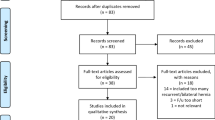Abstract
A meta-analysis of the EU Hernia Trialist Collaboration of all available prospective randomized trials could prove a significant lower recurrence rates for techniques with the use of mesh after primary repair of groin hernias (⊡ Table 29.1) [1, 2]. There was no statistical difference between the open and the endoscopic techniques in the recurrence rate after primary repair when a mesh was used. In the nationwide Danish hernia database as large prospective observational study of 26,304 herniorrhaphies the re-operation rates 30 months after anterior mesh repair and laparoscopic repair were significantly lower than after sutured posterior wall repairs in primary inguinal hernia (2.2 and 2.6% vs. 4.4%; p < 0.0001). Re-operation rates were also lower with anterior mesh repair (6.1%; p < 0.0001) and laparoscopic repair (3.4%) after recurrent hernia (⊡ Table 29.2) [3].
Access this chapter
Tax calculation will be finalised at checkout
Purchases are for personal use only
Preview
Unable to display preview. Download preview PDF.
Similar content being viewed by others
References
EU Hernia Trialist Collaboration (2000) Laparoscopic compared with open methods of groin hernia repair: systematic review of randomized controlled trials. Br J Surg 87: 860–867
EU Hernia Trialist Collaboration (2000) Mesh compared with non-mesh methods of open groin hernia repair: systematic review of randomized controlled trials. Br J Surg 87: 854–859
Bay-Nielsen M, Kehlet H, Strand L, Malmstrom J, Andersen FH, Wara P, Juul P, Callesen T; Danish Hernia Database Collaboration (2001) Quality assessment of 26.304 herniorrhaphies in Denmark: a prospective nationwide study. Lancet 358: 1124–1128
Bay-Nielsen M, Nordin P, Nilsson E, Kehlet H; Danish Hernia Database Collaboration (2001) Operative findings in recurrent hernia after a Lichtenstein procedure. Am J Surg 182: 134–136
Klosterhalfen B, Klinge U, Rosch, Junge K (2004) Long-term inertness of meshes. In: Schumpelick V, Nyhus LM (eds) Meshes: benefits and risks. Springer, Berlin Heidelberg New York, pp 170–178
Neumayer L, Giobbie-Hurder A, Jonasson O, et al. (2004) Open mesh versus laparoscopic mesh repair of inguinal hernia. N Engl J Med 350: 1819–27
Neumayer L (2004) Open mesh versus laparoscopic mesh hernia repair. N Engl J Med 350: 1463–1465; comment on: N Engl J Med 350: 1819–1827
Klinge U, Klosterhalfen B, Müller M, Öttinger AP, Schumpelick V (1998) Shrinking of polypropylene mesh in vivo. An experimental study in dogs. Eur J Surg 164: 965–969
Scheidbach H, Tamme C, Tannapfel A, Lippert H, Köckerling F (2004) In vivo studies comparing the biocompatibility of various polypropylene meshes and their handling properties during endoscopic total extraperitoneal (TEP) patchplasty. Surg Endosc 18: 211–220
Cobb WS, Kercher KW, Heniford BT (2005) The argument for lightweight polypropylene mesh in hernia repair. Surg Innov 12: 63–69
Greca FH, de Paula JB, Biondo-Simmoes ML, da Costa FD, da Silva AP, Times S, Mansur A (2001) The influence of differing pore sizes on biocompatibility of two polypropylene meshes in the repair of abdominal defects-experimental study in dogs. Hernia 5: 59–64
Junge K, Rosch R, Bialasinski L, Klinge U, Klosterhalfen B, Schumpelick V (2003) Persistent extracellular matrix remodelling at the interface to polymers used for hernia repair. Eur Surg Res 35: 497–504
Klinge U, Klosterhalfen B, Birkenhauer V, Junge K, Conze J, Schumpelick V (2002) Impact of polymer pore size on interface scar formation in a rat model. J Surg Res 103: 208–214
Schumpelick V, Klinge U, Welty G, Klosterhalfen B (2000) [Meshes within the abdominal wall]. Chirurg 70: 876–887
Knook MTT, van Rosmalen AC, Yoder BE, Kleinrensink GJ, Snijders CJ, Looman CWN, van Steensel CJ (2001) Optimal mesh size for endoscopic inguinal hernia repair: a study in a porcine model. Surg Endosc 15: 1471–1477
O’Dwyer PJ, Kingsnorth AN, Molloy RG, Small PK, Lammers B, Horeyseck G (2005) Randomized clinical trial assessing impact of lightweight or heavyweight mesh on chronic pain after inguinal hernia repair. Br J Surg 92: 166–170
Tamme C, Garde N, Klingler A, Hampe C, Wunder R, Köckerling F (2005) Totally extraperitoneal inguinal hernioplasty with titanium-coated lightweight polypropylene mesh: early results. Surg Endosc 19: 1125–1129
Author information
Authors and Affiliations
Editor information
Editors and Affiliations
Rights and permissions
Copyright information
© 2007 Springer-Verlag Berlin Heidelberg
About this chapter
Cite this chapter
Kockerling, F., Schug-Pass, C. (2007). Recurrence and Mesh Material. In: Schumpelick, V., Fitzgibbons, R.J. (eds) Recurrent Hernia. Springer, Berlin, Heidelberg. https://doi.org/10.1007/978-3-540-68988-1_29
Download citation
DOI: https://doi.org/10.1007/978-3-540-68988-1_29
Publisher Name: Springer, Berlin, Heidelberg
Print ISBN: 978-3-540-37545-6
Online ISBN: 978-3-540-68988-1
eBook Packages: MedicineMedicine (R0)




